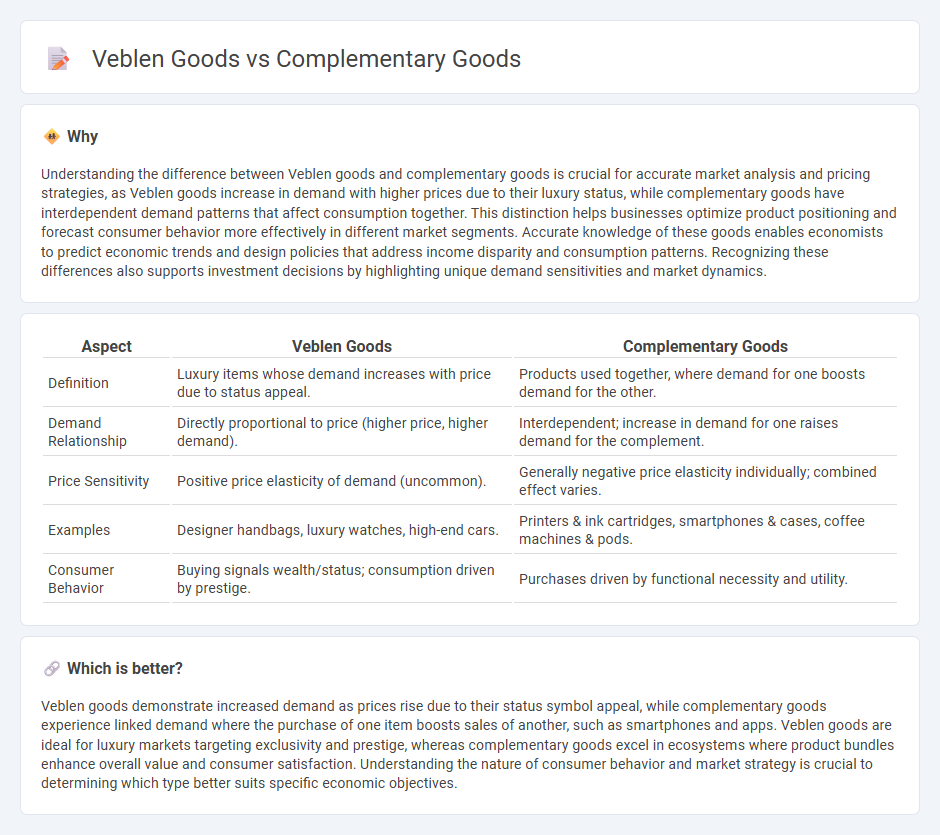
Veblen goods are luxury items whose demand increases as their prices rise, reflecting their status symbol appeal. Complementary goods are products that are consumed together, where the demand for one directly influences the demand for the other, such as printers and ink cartridges. Explore how these distinct economic concepts impact consumer behavior and market dynamics.
Why it is important
Understanding the difference between Veblen goods and complementary goods is crucial for accurate market analysis and pricing strategies, as Veblen goods increase in demand with higher prices due to their luxury status, while complementary goods have interdependent demand patterns that affect consumption together. This distinction helps businesses optimize product positioning and forecast consumer behavior more effectively in different market segments. Accurate knowledge of these goods enables economists to predict economic trends and design policies that address income disparity and consumption patterns. Recognizing these differences also supports investment decisions by highlighting unique demand sensitivities and market dynamics.
Comparison Table
| Aspect | Veblen Goods | Complementary Goods |
|---|---|---|
| Definition | Luxury items whose demand increases with price due to status appeal. | Products used together, where demand for one boosts demand for the other. |
| Demand Relationship | Directly proportional to price (higher price, higher demand). | Interdependent; increase in demand for one raises demand for the complement. |
| Price Sensitivity | Positive price elasticity of demand (uncommon). | Generally negative price elasticity individually; combined effect varies. |
| Examples | Designer handbags, luxury watches, high-end cars. | Printers & ink cartridges, smartphones & cases, coffee machines & pods. |
| Consumer Behavior | Buying signals wealth/status; consumption driven by prestige. | Purchases driven by functional necessity and utility. |
Which is better?
Veblen goods demonstrate increased demand as prices rise due to their status symbol appeal, while complementary goods experience linked demand where the purchase of one item boosts sales of another, such as smartphones and apps. Veblen goods are ideal for luxury markets targeting exclusivity and prestige, whereas complementary goods excel in ecosystems where product bundles enhance overall value and consumer satisfaction. Understanding the nature of consumer behavior and market strategy is crucial to determining which type better suits specific economic objectives.
Connection
Veblen goods and complementary goods intersect in consumer behavior dynamics where the demand for Veblen goods, luxury items like designer handbags, can drive increased demand for complementary goods, such as exclusive care products or accessories. The conspicuous consumption associated with Veblen goods elevates the perceived value of complementary goods, amplifying spending in related markets. This relationship underscores complex price elasticity patterns, where the premium pricing of Veblen goods influences the consumption rates of their complements, reinforcing luxury market ecosystems.
Key Terms
Demand elasticity
Complementary goods exhibit negative cross-price elasticity of demand, meaning that an increase in the price of one good decreases the demand for its complement, reflecting interdependent consumption patterns. In contrast, Veblen goods demonstrate positive price elasticity driven by perceived status effects, where higher prices lead to higher demand due to their luxury appeal. Explore further to understand how these distinct demand elasticities influence pricing strategies and consumer behavior.
Consumer preferences
Complementary goods exhibit a strong interdependence in consumer preferences, where the demand for one product increases as the demand for its complement rises, exemplified by printers and ink cartridges. Veblen goods defy typical demand patterns, as consumers prefer more expensive items like luxury watches or designer handbags, associating higher prices with prestige and status. Explore detailed consumer behavior patterns to understand how these categories uniquely influence market dynamics.
Price relationship
Complementary goods exhibit a negative price relationship, where a decrease in the price of one product leads to an increased demand for its complement, such as printers and ink cartridges. Veblen goods display a positive price relationship, as higher prices enhance their desirability and status appeal, increasing demand despite the price hike, evident in luxury brands like Rolex watches. Explore deeper insights into how price dynamics uniquely influence consumer behavior in these distinct markets.
Source and External Links
Guide to Complementary Goods: Definition and Examples - Indeed - Complementary goods are products that increase in value when the demand for related products increases, and a price change in one can affect the demand for its complement, like mobile phones and chargers or gaming consoles and accessories.
Complementary Goods - Economics Help - Complementary goods are products used together, such as tennis balls and rackets, which have a negative cross elasticity of demand where an increase in the price of one decreases demand for both.
What does Complementary Goods mean in Construction? - Vergo - In construction, complementary goods include materials, machinery, software, and services that work together to enhance productivity and project success.
 dowidth.com
dowidth.com